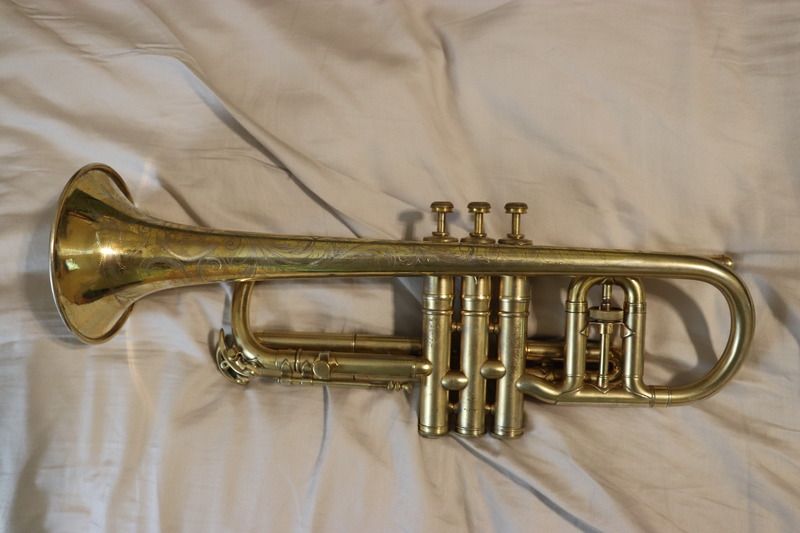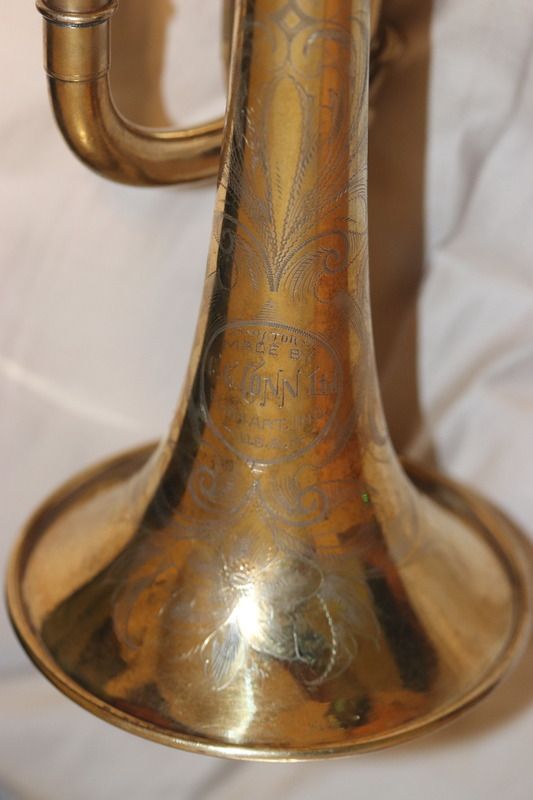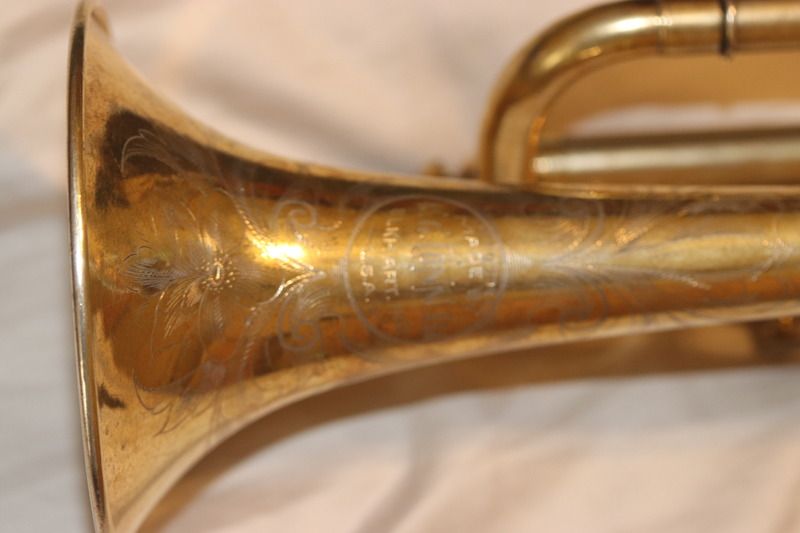| View previous topic :: View next topic |
| Author |
Message |
CartersPop
Regular Member

Joined: 20 May 2018
Posts: 68
Location: San Antonio
|
 Posted: Sat May 26, 2018 3:17 pm Post subject: Curious about my pop's old Conn cornet Posted: Sat May 26, 2018 3:17 pm Post subject: Curious about my pop's old Conn cornet |
 |
|
Hi folks, new to this forum, but not to music or trumpets/cornets. Have an interesting story that ends with a question that I hope you all can help with.
I recently was given a CG Conn Victor cornet that my father first obtained and used in the late 1930's, but which was owned continuously by either he or his younger brother, both music teachers and performers, until my fathers death at age 88 a little over a month ago. At that time he passed it on to me to give to my young son who has been learning to play a more recent model cornet over the past year. My dad's cornet is clearly marked as a Victor model, serial number 197106 (1922 manufacturing year by my research), has the opera glass tuning apparatus, also has an interconnecting B flat - A mechanism between the main tuning slide and all three valve slides, and extremely ornate engraving from the bell all the way down the flare of the bell pipe to the bracing that attaches it to the lead pipe at the mouthpiece reciever. It is for the most part in fading original gold tone, in remarkably good condition, very playable, with some wear through spots where it was gripped innumerable times and some lacquer loss, but does not have a single ding or dent after nearly 100 years of use. The obvious question of its value is not of great importance to me, as it is invaluable as a family memento and I never intend to sell it, although I am curious. My bigger question is more about trying to identify its precise model number. I measured the bore of one of the openings in the second valve itself at 15/32 inch (0.4625), which according to Conn Loyalist is a number 2 bore. But I cannot find any Victor cornet listings in their model lists for a Victor cornet from the 1922 era (from the serial number) possessing the opera glass B flat to A apparatus and the interlocking tuning slide to valve slide mechanism that came in a number 2 bore size. Have I measured the bore wrong? I do not wish to monkey with the interlink mechanism for fear of damaging the whole functioning system. Pictures below (only a couple but I have many others and can take more as needed). Anyone have any further ideas to ID this model to cure my curiosity for knowledge and posterity's sake? Thanks.


 [/img] [/img]
_________________
Olds NA5MS Cor
Conn '22 80A New Wonder Cor w/m
White '15 King Liberty Silver Trum
Conn '27 22B New York Symphony Trum
White '25 King Liberty Silver Trum
JinYin '15 Marching Bb Fr Horn
Conn '35 New Wonder 80A Corn w/m
Pan-Am '23 40I Bari |
|
| Back to top |
|
 |
connicalman
Heavyweight Member

Joined: 17 Dec 2007
Posts: 1668
Location: West Medford, MA
|
 Posted: Sat May 26, 2018 5:20 pm Post subject: Posted: Sat May 26, 2018 5:20 pm Post subject: |
 |
|
My condolences to you and your family. What a thoughtful and fortunate legacy for your son. This is a lovely old cornet, worth keeping in good shape for years to come.
I have a couple, and one is New Wonder from this era. It sings sweetly. The newer Victor is from the 60's and is not as warm. It is quite useful for marching gigs.
Their bore is Conn 2 1/2, 0.484". The mid-size model 38A was not yet in production, and their small bore jazz era models were definitely "small".
Tempting as it is to think you may have a one-off lab-bench experiment, try comparing the main slide, top to bottom diameters. The top should be close to 0.46, and the bottom, close to 0.48.
One tip often cited is to measure the outer diameter of the tube, then the thickness. Subtract twice the measured thickness. Good as I think I am at taking an inner diameter reading, doing the math gives me the answer closer to spec.
Last, keep the mouthpiece with this horn. Their taper and length changed slightly several times. These play better with the period mouthpiece. Good luck to your son. He has a really nice piece of history which he may listen to for clues, hints of how things were.
_________________
kochaavim, csillaagkep, αστερρισμός, konnstelacji, connstellation... ...a.k.a. the 28A!
Other Conns: Victor 5A & 38A, New Wonder & 80A; 'stella 38A; 36A; 'quest 76A... |
|
| Back to top |
|
 |
razeontherock
Heavyweight Member
Joined: 05 Jun 2004
Posts: 10609
Location: The land of GR and Getzen
|
 Posted: Sat May 26, 2018 7:10 pm Post subject: Posted: Sat May 26, 2018 7:10 pm Post subject: |
 |
|
| She's a beaut! My Dad just turned 85. Retired music teacher. My condolences. |
|
| Back to top |
|
 |
connicalman
Heavyweight Member

Joined: 17 Dec 2007
Posts: 1668
Location: West Medford, MA
|
 Posted: Sat May 26, 2018 7:26 pm Post subject: Posted: Sat May 26, 2018 7:26 pm Post subject: |
 |
|
[quote="connicalman"]My condolences to you and your family. What a thoughtful and fortunate legacy for your son. This is a lovely old cornet, worth keeping in good shape for years to come.
I have a couple, and one is New Wonder from this era. It sings sweetly. The newer Victor is from the 60's and is not as warm. It is quite useful for marching gigs.
Their bore is Conn 2 1/2, 0.484". The mid-size model 38A was not yet in production, and their small bore jazz era models were definitely "small".
Tempting as it is to think you may have a one-off lab-bench experiment, try comparing the main slide, top to bottom diameters. The top should be close to 0.46, and the bottom, close to 0.48...UPDATE
the 4A? The Conn Loyalist has pics...
One tip often cited is to measure the outer diameter of the tube, then the thickness. Subtract twice the measured thickness. Good as I think I am at taking an inner diameter reading, doing the math gives me the answer closer to spec.
Last, keep the mouthpiece with this horn. Their taper and length changed slightly several times. These play better with the period mouthpiece. Good luck to your son. He has a really nice piece of history which he may listen to for clues, hints of how things were.
_________________
kochaavim, csillaagkep, αστερρισμός, konnstelacji, connstellation... ...a.k.a. the 28A!
Other Conns: Victor 5A & 38A, New Wonder & 80A; 'stella 38A; 36A; 'quest 76A... |
|
| Back to top |
|
 |
CartersPop
Regular Member

Joined: 20 May 2018
Posts: 68
Location: San Antonio
|
 Posted: Sun May 27, 2018 12:21 am Post subject: Posted: Sun May 27, 2018 12:21 am Post subject: |
 |
|
Thanks for your sentiments. He had a very full life, especially given his roots, having not only been the first in our family EVER to attend college, let alone graduate, let alone complete a masters program, in music education, something he loved and lived all his life. As a matter of fact when he got the cornet back after his younger brother (my uncle) died several years ago, he got it put back into playing condition with the intent, in his early 80's, of getting back into playing in a community band as well as teaching and giving lessons, only to find his embouchre no longer functional due to nerve damage wrought by carotid artery surgeries a few years earlier.
Regarding the main slide internal diameters, due to the intricate Bflat-A interlink mechanism between the main slide and all three valve slides, I am not technically capable enough to be able to completely remove the main slide (or any one of the valve slides individually) in order to measure its proximal and distal IDs, as that entails taking apart the interlink mechanism, no simple task from what I can gather. Again, the openings of the channels in the second slide, as well as the third slide into which the downstream end of the main tuning slide flows, both measure out at 0.485 (15/32 inch). The lead pipe bore at the mouthpiece reciever measures 7/16 inch or 0.4375.
A couple other things about the horn: each valve piston has the horn serial number punched into upper portion that holds the spring; and the back bottom of the second valve casing has the words "patented" stamped very lightly into the finish level with two welded struts between first and second, and second and third valve casings. Not sure if any of that helps, although it does show that the valves are original to the rest of the horn.
From what I can gather by serial number 197106 it should be a 1922 model cornet. Victor, Made by CG Conn Ltd, Elkhart, Ind. USA is engraved clearly on the very ornate bell. From the 2nd valve opening measurement I believe the bore is 0.485 (Conn 2.0 bore number). It has both the opera glass as well as the valve slide Bflat-A interlinkage mechanism. And it is gold tone finish, at least what is left.
The only Conn Victors with the #2 bore I can find are a 4A built only from 1926-32 (too late for this serial number), a 8A #2 Bore Bb Victor Slender model built from 1932-41, a 12A #2 Bore Bb & A Coprion/Coprion Special built from 1938-55. The other typical opera glass Victors 80A, 81A, 84A, and 90A all have different bores, either larger or smaller. I guess maybe my error could be the bore measurement but without removing the second valve slide I cannot get more accurate.
_________________
Olds NA5MS Cor
Conn '22 80A New Wonder Cor w/m
White '15 King Liberty Silver Trum
Conn '27 22B New York Symphony Trum
White '25 King Liberty Silver Trum
JinYin '15 Marching Bb Fr Horn
Conn '35 New Wonder 80A Corn w/m
Pan-Am '23 40I Bari |
|
| Back to top |
|
 |
CartersPop
Regular Member

Joined: 20 May 2018
Posts: 68
Location: San Antonio
|
 Posted: Sun May 27, 2018 1:13 am Post subject: Posted: Sun May 27, 2018 1:13 am Post subject: |
 |
|
Well I guess I was misreading the Conn bore guide as the 0.484 2nd valve bore actually makes this a 2.5 bore not the 2.0 bore I originally thought. That means, for this particular 1922 model, that it should be an 81A, although now I am perplexed because that model is listed as a "high and low A" version which should come with a second set of valve slides and main slide to make that high-low A change. But this particular horn does not have them, nor any particular slots in the case that would be expected to securely house the second set of slides. There is a small cubby behind a panel in the case but is would not secure the second slide set in any way, rather allow them to rattle around against one another with each movement of the case while carried. So the mystery continues, albeit the possibilities are narrowed.
_________________
Olds NA5MS Cor
Conn '22 80A New Wonder Cor w/m
White '15 King Liberty Silver Trum
Conn '27 22B New York Symphony Trum
White '25 King Liberty Silver Trum
JinYin '15 Marching Bb Fr Horn
Conn '35 New Wonder 80A Corn w/m
Pan-Am '23 40I Bari |
|
| Back to top |
|
 |
nieuwguyski
Heavyweight Member

Joined: 06 Feb 2002
Posts: 2343
Location: Santa Cruz County, CA
|
 Posted: Wed May 30, 2018 10:56 pm Post subject: Posted: Wed May 30, 2018 10:56 pm Post subject: |
 |
|
I have a 1923 Conn Victor cornet with the Bb/A mechanism. The bore is definitely .485" and it came with what appears to be the original case -- with no room for extra slides.
Obsessively comparing my cornet to the "Conn Loyalist" picture of an 81A, I'm convinced my Victor is not a high-low pitch horn. My horn plays in low pitch, but the ferrules on the removable first and third-slide valve crooks are too short for there to a be higher-pitch alternative. I realize I just spewed some obscure jargon, but after multiple attempts to write an informative description I've given up.
At this point I have to question if the "New Wonder" model designation lasted as long as the Conn Loyalist model list claims. If anyone can produce a 1922 or later 80A "New Wonder" I'll eat crow, but I'm beginning to suspect that some time between 1918 and 1922 the "New Wonder" model was replaced by variations of the "Victor."
_________________
J. Notso Nieuwguyski |
|
| Back to top |
|
 |
OldSchoolEuph
Heavyweight Member

Joined: 07 Apr 2012
Posts: 2438
|
 Posted: Thu May 31, 2018 7:22 am Post subject: Posted: Thu May 31, 2018 7:22 am Post subject: |
 |
|
The Conn Victor ("Regular") Cornet, like many Conn models after Carl Greenleaf instituted the model numbering scheme, came in two variants: 80A and 81A. The horns are identical except that the 80A is built in Low Pitch, while the 81A is built in High Pitch and came with a second set of slides to adapt it to Low Pitch. It sounds like this is an 80A (which given that low pitch was formally adopted throughout the west by the signing of the treaty of Versailles ending WWI, which incorporated a 30+ year old convention on tuning pitch among the many treaties to remain in force, was probably the more common purchase in 1923)
_________________
Ron Berndt
www.trumpet-history.com
2017 Austin Winds Stage 466
1962 Mt. Vernon Bach 43
1954 Holton 49 Stratodyne
1927 Conn 22B
1957 Holton 27 cornet
1985 Yamaha YEP-621
1975 Yamaha YEP-321 Custom
1965 Besson Baritone
1975 Olds Recording R-20 |
|
| Back to top |
|
 |
|
|
You cannot post new topics in this forum
You cannot reply to topics in this forum
You cannot edit your posts in this forum
You cannot delete your posts in this forum
You cannot vote in polls in this forum
|
Powered by phpBB © 2001, 2005 phpBB Group
|